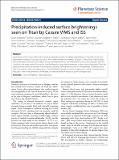| dc.contributor.author | Barnes, Jason W. | |
| dc.contributor.author | Buratti, Bonnie J. | |
| dc.contributor.author | Turtle, Elizabeth P. | |
| dc.contributor.author | Bow, Jacob | |
| dc.contributor.author | Dalba, Paul A. | |
| dc.contributor.author | Perry, Jason | |
| dc.contributor.author | Brown, Robert H. | |
| dc.contributor.author | Rodriguez, Sebastien | |
| dc.contributor.author | Mouelic, Stephane Le | |
| dc.contributor.author | Baines, Kevin H. | |
| dc.contributor.author | Sotin, Christophe | |
| dc.contributor.author | Lorenz, Ralph D. | |
| dc.contributor.author | Malaska, Michael J. | |
| dc.contributor.author | McCord, Thomas B. | |
| dc.contributor.author | Clark, Roger N. | |
| dc.contributor.author | Jaumann, Ralf | |
| dc.contributor.author | Hayne, Paul O. | |
| dc.contributor.author | Nicholson, Philip D. | |
| dc.contributor.author | Soderblom, Jason M. | |
| dc.contributor.author | Soderblom, Laurence A. | |
| dc.date.accessioned | 2013-05-07T17:48:01Z | |
| dc.date.available | 2013-05-07T17:48:01Z | |
| dc.date.issued | 2013-01 | |
| dc.date.submitted | 2012-03 | |
| dc.identifier.issn | 2191-2521 | |
| dc.identifier.uri | http://hdl.handle.net/1721.1/78838 | |
| dc.description.abstract | Abstract Observations from Cassini VIMS and ISS show localized but extensive surface brightenings in the wake of the 2010 September cloudburst. Four separate areas, all at similar latitude, show similar changes: Yalaing Terra, Hetpet Regio, Concordia Regio, and Adiri. Our analysis shows a general pattern to the time-sequence of surface changes: after the cloudburst the areas darken for months, then brighten for a year before reverting to their original spectrum. From the rapid reversion timescale we infer that the process driving the brightening owes to a fine-grained solidified surface layer. The specific chemical composition of such solid layer remains unknown. Evaporative cooling of wetted terrain may play a role in the generation of the layer, or it may result from a physical grain-sorting process. | en_US |
| dc.description.sponsorship | National Aeronautics and Space Administration. ESA Cassini Project | en_US |
| dc.publisher | Springer | en_US |
| dc.relation.isversionof | http://dx.doi.org/10.1186/2191-2521-2-1 | en_US |
| dc.rights | Creative Commons Attribution | en_US |
| dc.rights.uri | http://creativecommons.org/licenses/by/2.0 | en_US |
| dc.source | BMC | en_US |
| dc.title | Precipitation-induced surface brightenings seen on Titan by Cassini VIMS and ISS | en_US |
| dc.type | Article | en_US |
| dc.identifier.citation | Barnes, Jason W. et al. “Precipitation-induced Surface Brightenings Seen on Titan by Cassini VIMS and ISS.” Planetary Science 2.1 (2013): 1. | en_US |
| dc.contributor.department | Massachusetts Institute of Technology. Department of Earth, Atmospheric, and Planetary Sciences | en_US |
| dc.contributor.mitauthor | Soderblom, Jason | |
| dc.relation.journal | Planetary Science | en_US |
| dc.eprint.version | Author's final manuscript | en_US |
| dc.type.uri | http://purl.org/eprint/type/JournalArticle | en_US |
| eprint.status | http://purl.org/eprint/status/PeerReviewed | en_US |
| dc.date.updated | 2013-05-03T05:46:29Z | |
| dc.language.rfc3066 | en | |
| dc.rights.holder | Jason W Barnes et al.; licensee BioMed Central Ltd. | |
| dspace.orderedauthors | Barnes, Jason W; Buratti, Bonnie J; Turtle, Elizabeth P; Bow, Jacob; Dalba, Paul A; Perry, Jason; Brown, Robert H; Rodriguez, Sebastien; Mouélic, Stéphane Le; Baines, Kevin H; Sotin, Christophe; Lorenz, Ralph D; Malaska, Michael J; McCord, Thomas B; Clark, Roger N; Jaumann, Ralf; Hayne, Paul O; Nicholson, Philip D; Soderblom, Jason M; Soderblom, Laurence A | en |
| dspace.mitauthor.error | true | |
| mit.license | OPEN_ACCESS_POLICY | en_US |
| mit.metadata.status | Complete | |
